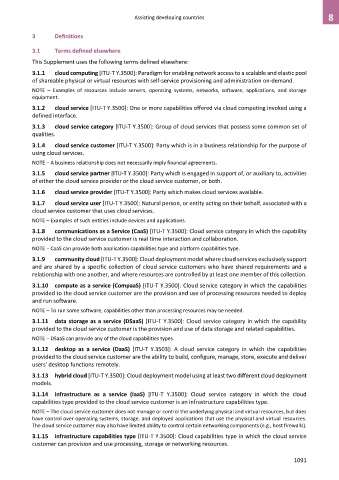Page 1099 - Cloud computing: From paradigm to operation
P. 1099
Assisting developing countries 8
3 Definitions
3.1 Terms defined elsewhere
This Supplement uses the following terms defined elsewhere:
3.1.1 cloud computing [ITU-T Y.3500]: Paradigm for enabling network access to a scalable and elastic pool
of shareable physical or virtual resources with self-service provisioning and administration on-demand.
NOTE – Examples of resources include servers, operating systems, networks, software, applications, and storage
equipment.
3.1.2 cloud service [ITU-T Y.3500]: One or more capabilities offered via cloud computing invoked using a
defined interface.
3.1.3 cloud service category [ITU-T Y.3500]: Group of cloud services that possess some common set of
qualities.
3.1.4 cloud service customer [ITU-T Y.3500]: Party which is in a business relationship for the purpose of
using cloud services.
NOTE – A business relationship does not necessarily imply financial agreements.
3.1.5 cloud service partner [ITU-T Y.3500]: Party which is engaged in support of, or auxiliary to, activities
of either the cloud service provider or the cloud service customer, or both.
3.1.6 cloud service provider [ITU-T Y.3500]: Party which makes cloud services available.
3.1.7 cloud service user [ITU-T Y.3500]: Natural person, or entity acting on their behalf, associated with a
cloud service customer that uses cloud services.
NOTE – Examples of such entities include devices and applications.
3.1.8 communications as a Service (CaaS) [ITU-T Y.3500]: Cloud service category in which the capability
provided to the cloud service customer is real time interaction and collaboration.
NOTE – CaaS can provide both application capabilities type and platform capabilities type.
3.1.9 community cloud [ITU-T Y.3500]: Cloud deployment model where cloud services exclusively support
and are shared by a specific collection of cloud service customers who have shared requirements and a
relationship with one another, and where resources are controlled by at least one member of this collection.
3.1.10 compute as a service (CompaaS) [ITU-T Y.3500]: Cloud service category in which the capabilities
provided to the cloud service customer are the provision and use of processing resources needed to deploy
and run software.
NOTE – To run some software, capabilities other than processing resources may be needed.
3.1.11 data storage as a service (DSaaS) [ITU-T Y.3500]: Cloud service category in which the capability
provided to the cloud service customer is the provision and use of data storage and related capabilities.
NOTE – DSaaS can provide any of the cloud capabilities types.
3.1.12 desktop as a service (DaaS) [ITU-T Y.3503]: A cloud service category in which the capabilities
provided to the cloud service customer are the ability to build, configure, manage, store, execute and deliver
users' desktop functions remotely.
3.1.13 hybrid cloud [ITU-T Y.3500]: Cloud deployment model using at least two different cloud deployment
models.
3.1.14 infrastructure as a service (IaaS) [ITU-T Y.3500]: Cloud service category in which the cloud
capabilities type provided to the cloud service customer is an infrastructure capabilities type.
NOTE – The cloud service customer does not manage or control the underlying physical and virtual resources, but does
have control over operating systems, storage, and deployed applications that use the physical and virtual resources.
The cloud service customer may also have limited ability to control certain networking components (e.g., host firewalls).
3.1.15 infrastructure capabilities type [ITU-T Y.3500]: Cloud capabilities type in which the cloud service
customer can provision and use processing, storage or networking resources.
1091

